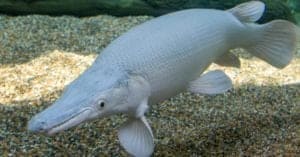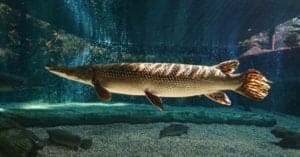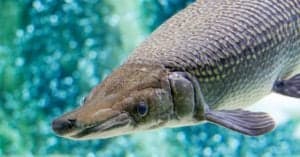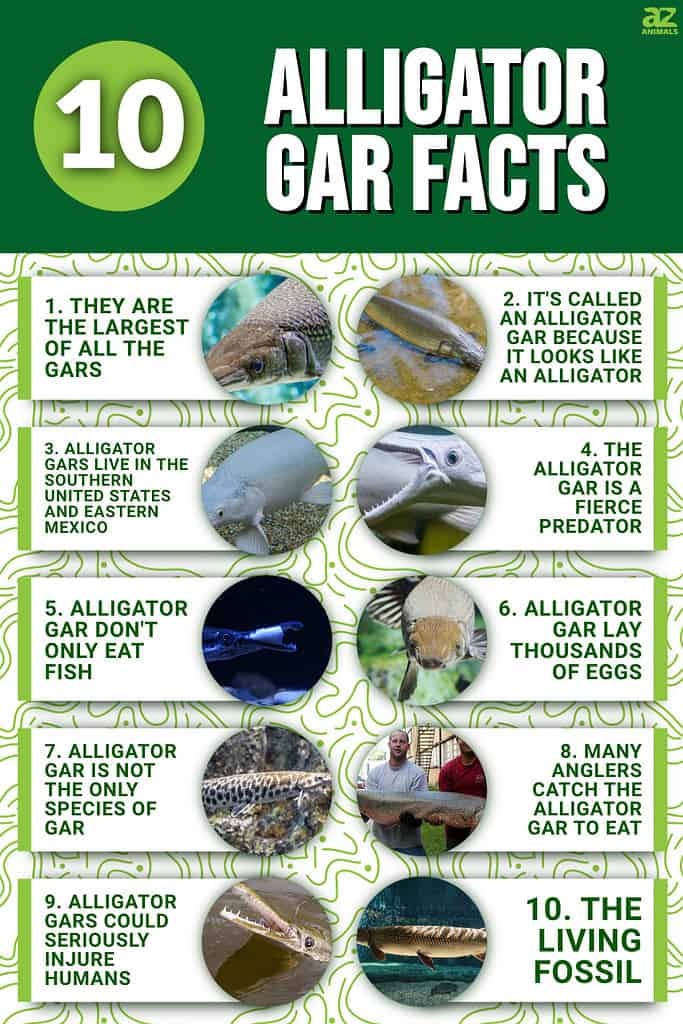
Alligator gars are fascinating fish that are named for their resemblance to alligators. However, thankfully they are not as dangerous. Alligator gars are pretty large, and people regard them as hazardous because of their size. But this gar, the second-largest freshwater fish in North America and a living fossil, actually helps to maintain fish populations. Read on to discover even more incredible alligator gar facts!
1. They Are the Largest of all the Gars
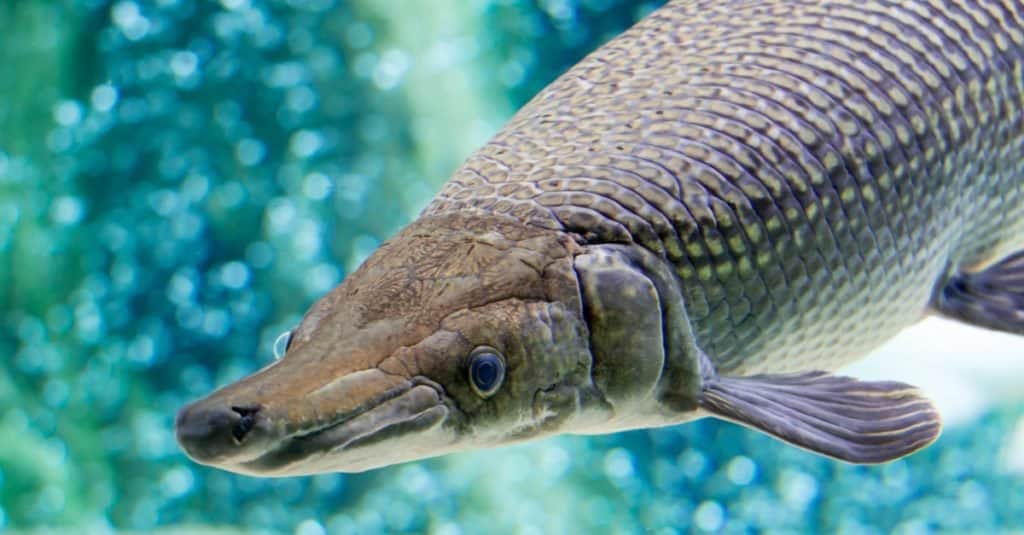
Alligator gars can grow to 10 feet in length and weigh up to 300 pounds.
©Bill Roque/Shutterstock.com
Alligator gars are the largest species of garfish. These fish usually weigh up to 300 pounds and reach up to 10 feet in length, ensuring they are some of the biggest freshwater fish in North America. Male alligator gars are often larger than the females. The biggest alligator gar documented was caught in Mississippi’s Lake Chotard in 2011 and weighed a massive 327 pounds.
2. It’s Called an Alligator Gar because It looks like an Alligator
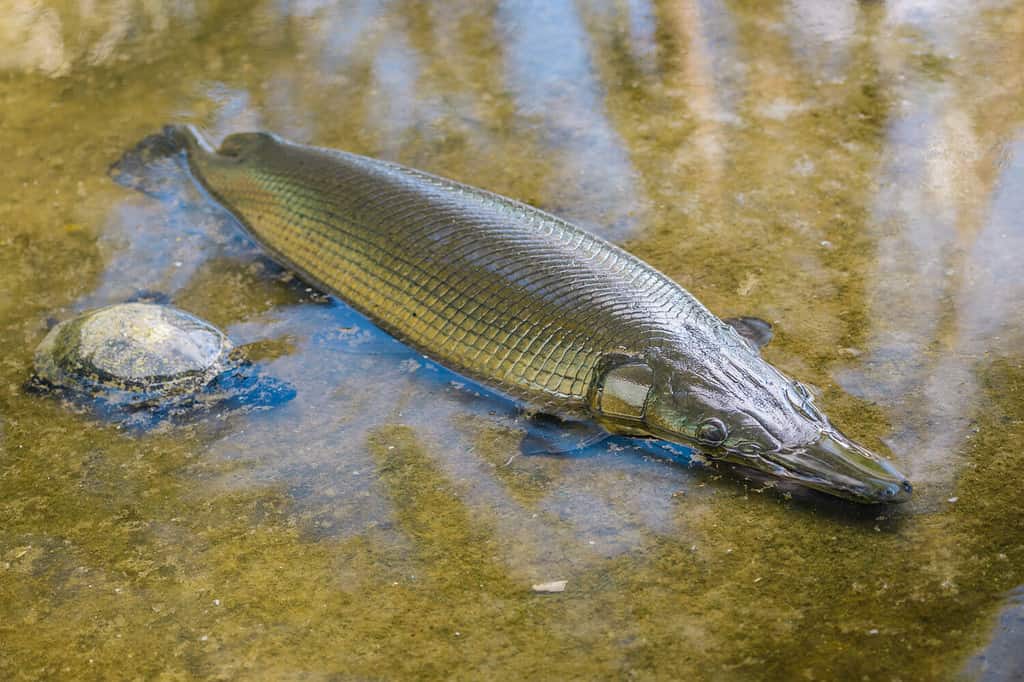
Alligator gars often come up to the surface and are mistaken for gators.
©DeepGreen/Shutterstock.com
Alligators have long, thin bodies, snouts, and a row of sharp teeth. Alligator gars have the same features as alligators but also have pectoral, pelvic, dorsal, and anal fins. Alligator gars have various color variations, like gray, green, and brown. They also have dark spots on their backs which fade to white or yellow as they reach the lower stomach. Alligator gars also have a bladder that functions like a lung, allowing them to survive in low-oxygen water. They can also tolerate small amounts of salt water but don’t live in the open oceans.
3. Alligator Gars Live in the Southern United States and Eastern Mexico
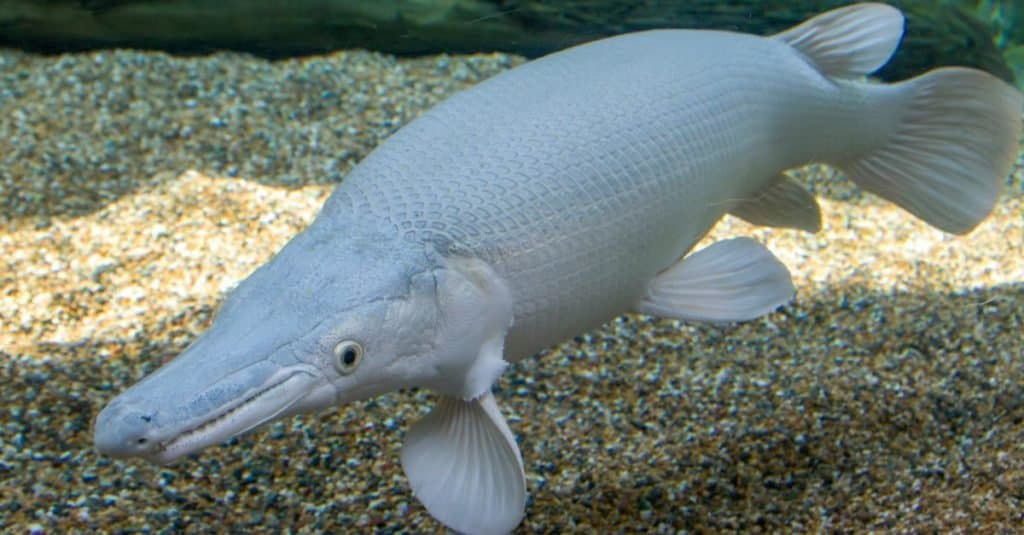
Alligator gars live in freshwaters across the southern United States and Mexico.
©Danny Ye/Shutterstock.com
Alligator gars live in lakes, rivers, estuaries, swamps, bayous, and reservoirs across the southern regions of the United States and eastern Mexico. They used to live in Iowa and Nebraska, but their populations died out because of excessive fishing. Despite being extensively hunted in Iowa and Nebraska, the alligator gars are of the least concern, according to the IUCN Red List. Most of their threats, besides overhunting, are pollution and habitat changes, but this has not significantly damaged their numbers
4. The Alligator Gar is a Fierce Predator

Like the alligator it is named for – alligator gars are fierce ambush predators.
Image: Charlotte Bleijenberg, Shutterstock
©Charlotte Bleijenberg/Shutterstock.com
Another incredible alligator gar fact is how they are such skilled hunters. These gars are smart, ambush predators that wait for their prey. They will lie on the bottom of a riverbed or lake or slowly swim a few feet below their target before attacking. Alligator gar attacks their prey by lunging forward in a sweeping motion and grabbing their prey using their enormous jaws. They have evolved into fierce predators with excellent vision and can sense chemicals from their prey. But these gars do not significantly deplete fish stocks. Instead, they help to maintain healthy fish populations.
5. Alligator Gar don’t only Eat Fish

Large alligator gars eat turtles, birds, and small mammals.
Image: Wilson Anyie, Shutterstock
©Wilson Anyie/Shutterstock.com
These carnivorous gars eat smaller fish like carp and shad. However, they will also eat almost any creature that can fit in their mouths. Besides fish, alligator gar eat turtles, birds, and even small mammals.
6. Alligator Gar Lay Thousands of Eggs
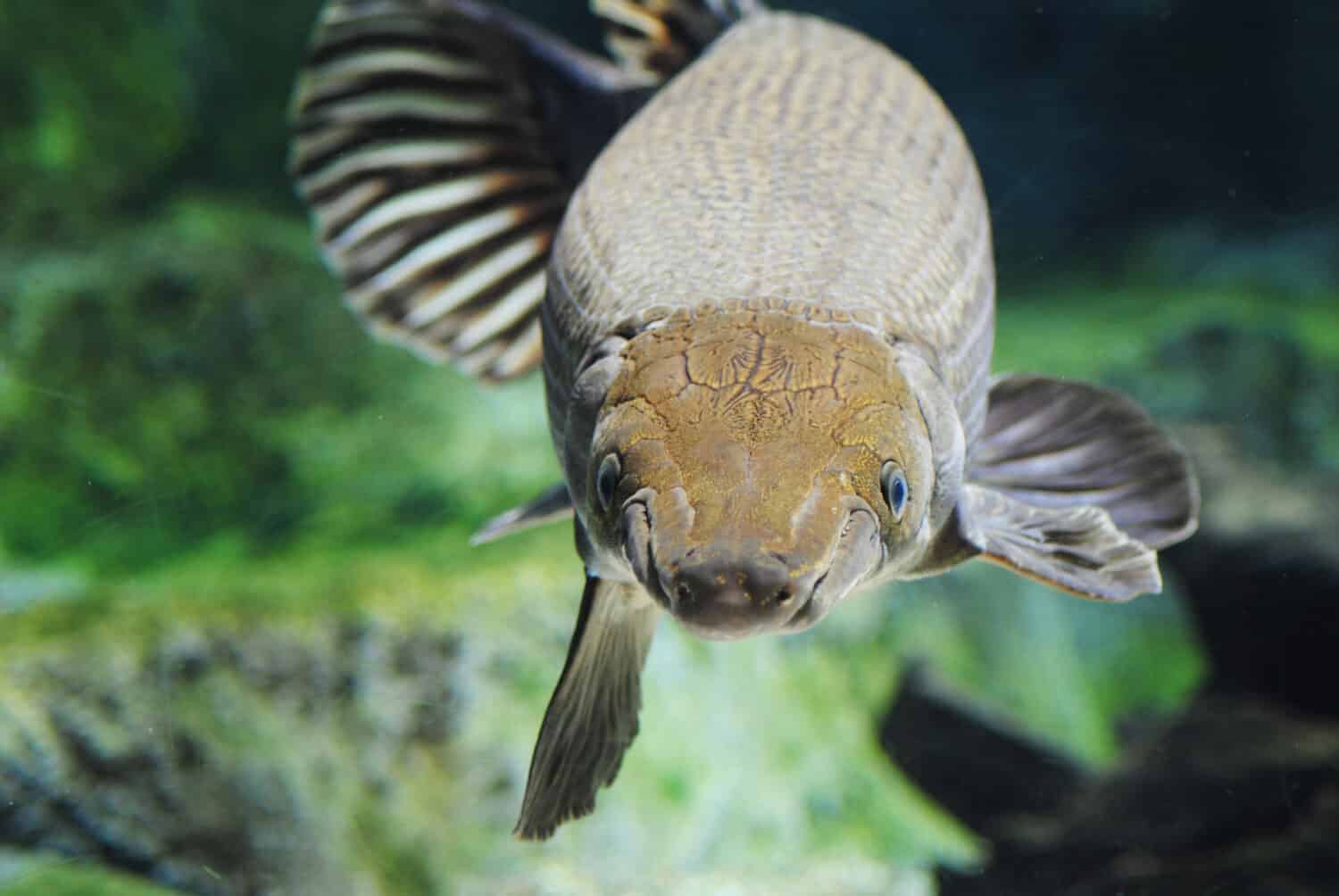
Female alligator gars lay up to 30,000 eggs per year.
Image: Morrissey Design Studio, Shutterstock
©Morrissey Design Studio/Shutterstock.com
One of the most incredible alligator gar facts is that the females can carry and lay thousands of eggs! The breeding season usually takes place from May to July. Some female gars do not reproduce yearly and will only reproduce if the water overruns the banks to create floodplains. The female gar will then lay up to 30,000 eggs per year on the rocks and vegetation near the banks of the water source.
The eggs will hatch after six to eight days and absorb all the yolk until none remains. Many of the young will die from predation, but the ones who survive will grow rapidly in their first two years. Alligator gars reach sexual maturity at approximately 11 years and can live to over 50 years old in the wild.
7. Alligator Gar is Not the Only Species of Gar

An interesting spotted gar fact is that it looks like the alligator gar but is smaller and has beautiful spotted markings.
©volkova natalia/Shutterstock.com
Other gar species are the shortnose gar, spotted gar, and longnose gar. The shortnose gar has a short, broad snout and is not as large as the alligator gar. The spotted gar looks similar to the shortnose gar but has black spots on its head and fins. The longnose gar has the longest and thinnest snout of all the different gar species.
8. Many Anglers Catch the Alligator Gar to Eat
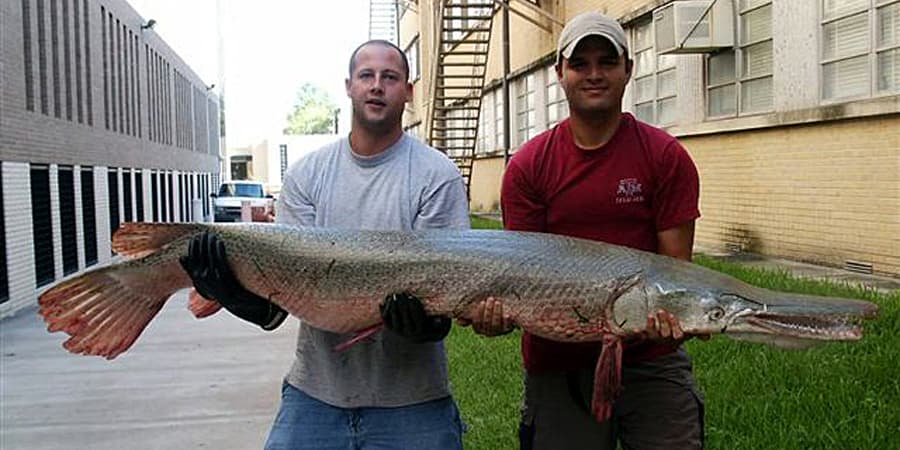
Alligator gars grow to huge sizes and are considered by anglers to be quite tasty.
©Clinton & Charles Robertson / CC BY-SA 4.0 – License
Catching the alligator gar is not easy as these fish are fierce and will put up a good fight because they’re game fish. Yet that doesn’t stop anglers from catching them. Besides providing anglers with a good hunt, their meat is also suitable for consumption, making recreational angling for this fish a worthwhile challenge. Alligator gars have white, firm flesh and a mild taste. People cook alligator gar by frying or barbecuing them.
9. Alligator Gars could Seriously Injure Humans
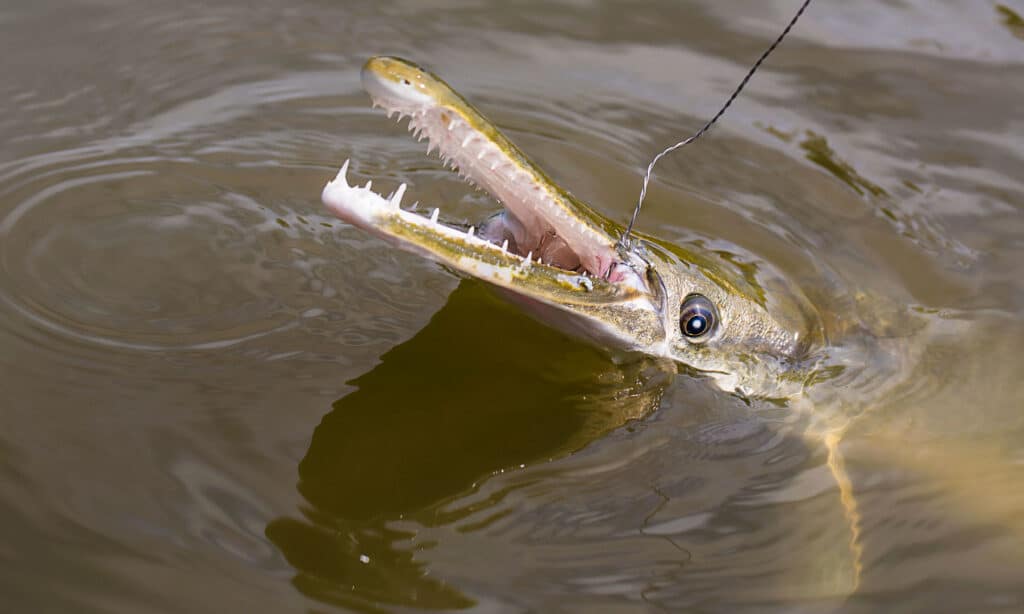
Alligator gar have sharp teeth and strong jaws that could cause an excruciating injury to humans.
©Jennifer White Maxwell/Shutterstock.com
These predatory fish in the wild are more passive than ones in captivity. But, the fact is that a captive alligator gar may become aggressive in a tank with insufficient space or food. Alligator gars also have giant mouths with sharp teeth that evolved to eat prey like turtles and snakes. It would be excruciating if an alligator gar were to bite a person. However, anecdotal reports provide some evidence of alligator gars attacking people, although no documented cases exist.
10. The Living Fossil
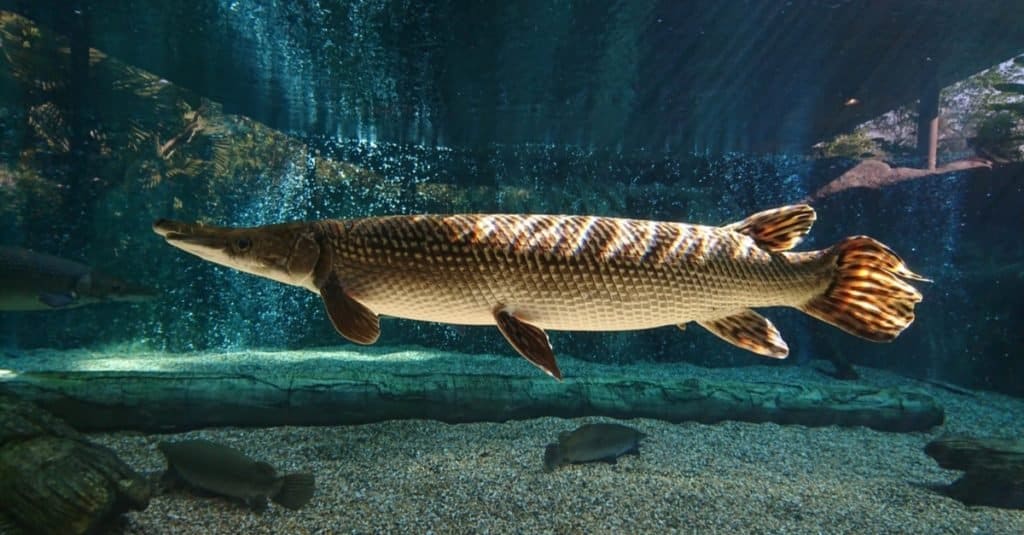
Alligator gar look almost exactly the same today as their relatives did millions of years ago
©Cheng Wei/Shutterstock.com
The final incredible alligator gar fact we have for you today is that they are known as “living fossils”. Charles Darwin himself described alligator gars as “living fossils” because of their primitive anatomy and the fact that they look almost exactly the same as their ancestors did thousands of years ago. Their relatives first existed approximately 157 million years ago and were found right across the world.
The photo featured at the top of this post is © TKBackyard/Shutterstock.com
Sources
- Seaworld, Available here: https://seaworld.org/animals/facts/bony-fish/gars/
- Kidadl, Available here: https://kidadl.com/facts/animals/alligator-gar-facts
- Life of Fish, Available here: https://lifeoffish.com/alligator-gar-size-12-interesting-facts-you-must-know/#What_is_the_giant_alligator_gar
- Missouri Department of Conservation, Available here: https://mdc.mo.gov/discover-nature/field-guide/alligator-gar
Thank you for reading! Have some feedback for us? Contact the AZ Animals editorial team.



